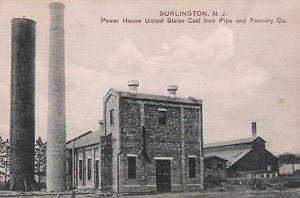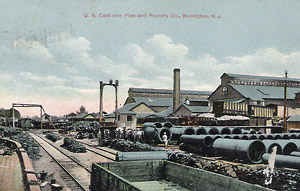1101 East Pearl Street, Burlington, NJ | View Map

Postcard of U.S. Pipe and Cast Iron. Credit: Herman Costello Collection
Southern New Jersey’s plentiful supplies of water, wood, and bog ore provided the essential ingredients for iron making, one of the state’s earliest and most important industries. In the nineteenth century, cast iron pipe became one of the key specialty products in the Delaware Valley, and the pipe-making industry flourished. Demand for industrial iron pipe expanded with the growth in towns and cities in the nineteenth century. This increase in urban population fueled demand for municipal services and reliable gas, water, and sewage conduction systems. During the same period, technological changes made standardized large-scale iron production possible.
In the 1870s, Burlington businessman Andrew H. McNeal (1839–1908) helped establish a company here to produce iron pipe for this growing market. That company eventually became Burlington’s largest industry and part of one the largest pipe manufacturers in the United States. Andrew McNeal grew up in the foundry business. His father John established a cast iron pipe foundry in Bristol, Pennsylvania, which the family relocated to Burlington after the Civil War. By that time, Burlington afforded excellent railroad and river steamer connections for a growing business. In 1866, McNeal started purchasing land — eventually totaling 131 acres — on Leasey Point, site of a seventeenth-century tavern. John H. McNeal & Sons built its first foundry there in 1872. This early facility contained a long narrow casting house and machine shop made of stone, auxiliary buildings, and a dock. Andrew McNeal became the primary owner of the firm in the 1880s and continued to expand the plant. The McNeal foundries manufactured iron pipe using vertical pit casting, a technologically advanced process. This new process replaced the slower and less predictable Scotch or “cast on the side” method and transformed the cast iron pipe industry. The foundry produced up to 200 tons per day of melted iron for pipes ranging from 1.5 inches to four feet in diameter.

Postcard of U.S. Pipe and Cast Iron. Credit: Herman Costello Collection
In 1899, McNeal sold his interest to a new corporation that consolidated pipe-making facilities in eight states. Chartered in New Jersey, the giant United States Cast Iron Pipe & Foundry Company produced seventy-five percent of all American pipes by 1900. In the 1920s, U.S. Pipe expanded the Burlington factory and continued development of new manufacturing processes and products, including specialized products for sugar processing and chemical production that were shipped worldwide. The company was the largest employer in the city.
In the 1890s, Andrew McNeal had constructed a three-story brick and stucco mansion at the edge of the foundry property. The mansion was sited next to the river and surrounded by landscaped lawns and specimen trees. The 10,000 square foot residence was the largest and most elegant in the county. After McNeal sold his company, his residence became the corporate headquarters and research facility of U.S. Pipe. Three wings were added to the mansion during the 1920s and 1930s. After the company relocated its headquarters to another state, the McNeal mansion became a regional office. The McNeal mansion is listed in the New Jersey Register of Historic Places. In 1975 U.S. Pipe sold the mansion to the city of Burlington.
For more information:
- www.uspipe.com
- www.encyclopedia.com/doc/1G2-3428900109.html
- www.nationalregisterofhistoricplaces.com/nj/Burlington/state.html
- www.burlingtoncountyhistoricalsociety.org
- www.njtransit.com
Banner art: McNeal Mansion. Credit: Collections of Burlington County Historical Society






